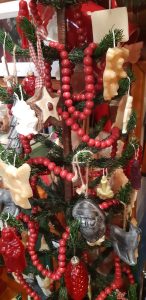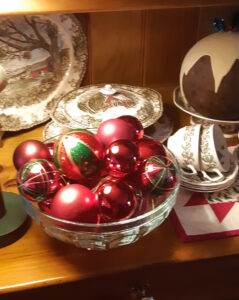 Our Christian forefathers had a battle on their hands. How to bring the Word of God and the message of Christ’s birth to a world that was essentially pagan in so many regards … pagans celebrating such things as Roman, Celtic, Norse, Druid and other traditions which they had done for centuries. There was the annual Roman observation of Saturnalia from the 17th to the 24th of December which honoured the agricultural god Saturn with feasting, drinking, giving gifts, and being ‘joyful’ with abandon. This tied in with the Northern Hemisphere winter solstice – the shortest day of the year – smack bang in the middle of December, marking the end ‘figuratively speaking’ of the coldest day of the year and the turning point towards spring and summer.
Our Christian forefathers had a battle on their hands. How to bring the Word of God and the message of Christ’s birth to a world that was essentially pagan in so many regards … pagans celebrating such things as Roman, Celtic, Norse, Druid and other traditions which they had done for centuries. There was the annual Roman observation of Saturnalia from the 17th to the 24th of December which honoured the agricultural god Saturn with feasting, drinking, giving gifts, and being ‘joyful’ with abandon. This tied in with the Northern Hemisphere winter solstice – the shortest day of the year – smack bang in the middle of December, marking the end ‘figuratively speaking’ of the coldest day of the year and the turning point towards spring and summer.
As Christianity spread throughout Europe in the early ADs, missionaries got to know a lot of different groups of people with varying religious systems and beliefs. All of these people and religions were lumped into the catch-all term of ‘pagan’. Although Christians had the goal of spreading their religion across Europe, they were still quite fascinated by many of the customs and ways of the pagans. Clearly they were fascinated enough to pick up a few of the pagans’ beliefs and traditions and adapt them as part of Christian Christmas – birth of Jesus Christ – celebrations!
 In many regards they figured it was easier to give new meaning and interpretations to these entrenched observations than start from scratch and try and bring people out of their paganism and learn news ways of celebration.
In many regards they figured it was easier to give new meaning and interpretations to these entrenched observations than start from scratch and try and bring people out of their paganism and learn news ways of celebration.
While so many of the true ‘conversion of pagan rituals and the start of Christianisation of rituals and trappings’ are lost in the mists of time, as the centuries have passed there are now conflicting explanations as to how one thing pagan was turned into another thing Christian. Suffice to say that today, a multiplicity of our traditional Christian Christmas celebrations, rituals and the trappings of the season really do have some sort of non-Christian foundation.
Here are just a few …
December 25th Christmas Day
 Why we celebrate Christmas in December, and specifically why we observe Christmas Day on December 25th is something that, as with so many other traditions of the season, harks back to pagan days and the Christianisation of a people whose beliefs were founded on seasons and planets, nature and the realities of human life … things both tangible and others imagined. It is believed that the first time Christmas Day was observed on December 25th occurred in 336AD when the very first Christian Roman Emperor, Constantine, celebrated the birth of Jesus. Pope Julius I officially declared the date a few years later.
Why we celebrate Christmas in December, and specifically why we observe Christmas Day on December 25th is something that, as with so many other traditions of the season, harks back to pagan days and the Christianisation of a people whose beliefs were founded on seasons and planets, nature and the realities of human life … things both tangible and others imagined. It is believed that the first time Christmas Day was observed on December 25th occurred in 336AD when the very first Christian Roman Emperor, Constantine, celebrated the birth of Jesus. Pope Julius I officially declared the date a few years later.
Interestingly, the word ‘Christmas’ is drawn from the two words Christ’s Mass … an early Christian church celebration of mass to mark the birth of Jesus.
Some theologians believe that December 25th was chosen as a consequence of the story in the Gospel of Luke where Mary was visited be the angel Gabriel. Calculations by such learned folk put the visitation at the 25th of March. Working forward from this declaration that Mary would bear a son, they deducted that His delivery would be nine months later – December 25th!
 There are, however, more common theories state that, in order to bring Christianity to an otherwise suspicious and pagan world, early Christian scholars and priests took the pagan December 25th celebration of the northern hemisphere Saturnalia or winter solstice and designated it to be the day Jesus was born. Saturnalia marked the end of the cold and earthly ‘death’ and designated a turning point for the earth as ‘life’ returned. The coming of summer, growth, warmth and light was thus reinterpreted by the early church as representing the day Jesus – the ultimate gift of new life from above – was born.
There are, however, more common theories state that, in order to bring Christianity to an otherwise suspicious and pagan world, early Christian scholars and priests took the pagan December 25th celebration of the northern hemisphere Saturnalia or winter solstice and designated it to be the day Jesus was born. Saturnalia marked the end of the cold and earthly ‘death’ and designated a turning point for the earth as ‘life’ returned. The coming of summer, growth, warmth and light was thus reinterpreted by the early church as representing the day Jesus – the ultimate gift of new life from above – was born.
So, the early church chose December 25 to ‘absorb’ the festivities surrounding these deities- and refocused them on the birth of Christ. While some Christians regarded this acquisition as a victory, others such as Augustine of Hippo had to keep reminding people it was the Son of God and not the sun they were worshipping.
Gift Giving
 Back in pagan days, Romans exchanged small gifts for the sake of good luck at Saturnalia. The idea was to give a gift in the hope of bringing in a bountiful harvest the next year. Rather than have huge lists of gifts to give, the Romans shared only one gift with one other person. As Jesus represents the greatest gift of all, early church forefathers maintained the tradition of gift giving in observation of presenting tokens from one to the other … in acknowledgement of this Christian truth.
Back in pagan days, Romans exchanged small gifts for the sake of good luck at Saturnalia. The idea was to give a gift in the hope of bringing in a bountiful harvest the next year. Rather than have huge lists of gifts to give, the Romans shared only one gift with one other person. As Jesus represents the greatest gift of all, early church forefathers maintained the tradition of gift giving in observation of presenting tokens from one to the other … in acknowledgement of this Christian truth.
Carolling
 The original Christmas carols were not Christian hymns; they were pagan seasonal songs to drive away evil. People would go door-to-door singing to their neighbours in observation of the pagan tradition called wassailing. The word comes from the Anglo-Saxon phrase of ‘waes hael’, translating to ‘good health’. Every year, wassailers would roam through their villages in small groups, singing loudly with the aim of banishing evil spirits and wishing good health to those around them. No wassailing group was complete without their traditional drink on hand – made from mulled ale, curdled cream, roasted apples, eggs, spices, and sugar. In the 13th century, St. Francis took inspiration from these choirs and started the tradition of Christmas carolling.
The original Christmas carols were not Christian hymns; they were pagan seasonal songs to drive away evil. People would go door-to-door singing to their neighbours in observation of the pagan tradition called wassailing. The word comes from the Anglo-Saxon phrase of ‘waes hael’, translating to ‘good health’. Every year, wassailers would roam through their villages in small groups, singing loudly with the aim of banishing evil spirits and wishing good health to those around them. No wassailing group was complete without their traditional drink on hand – made from mulled ale, curdled cream, roasted apples, eggs, spices, and sugar. In the 13th century, St. Francis took inspiration from these choirs and started the tradition of Christmas carolling.
Many of the familiar carols sung today were written in the nineteenth century to revive the carolling tradition.
The Christmas Tree
 The Christmas tree which is believed to have its beginnings in old Roman days and, again, the annual festival of ‘Saturnalia’ which, held in December, celebrated the god Saturn. Here evergreen trees would be decorated with gifts and other adornments in honour of the ancient sun god. The ancients also used the evergreen in many of their pagan observances to symbolise immortality. Many theological scholars believe that the Christmas tree was therefore utilised by early Christian leaders to help observe the birth of Jesus – the one true ‘immortal’ of all time.
The Christmas tree which is believed to have its beginnings in old Roman days and, again, the annual festival of ‘Saturnalia’ which, held in December, celebrated the god Saturn. Here evergreen trees would be decorated with gifts and other adornments in honour of the ancient sun god. The ancients also used the evergreen in many of their pagan observances to symbolise immortality. Many theological scholars believe that the Christmas tree was therefore utilised by early Christian leaders to help observe the birth of Jesus – the one true ‘immortal’ of all time.
The ancient Celtic tribes of Europe, as well as the Vikings and Saxons all venerated trees as symbols of life, tying offerings to their boughs.
Other researchers say that the Christmas tree as we know it today has its origins in medieval times when, as part of the process of the early church preaching the gospel to a largely-illiterate population, ‘miracle plays’ would be staged in town and village centres. These plays would depict the stories of the Bible, Christ’s birth and the times of the early saints. An evergreen – often adorned with red apples (thus the tradition of the green Christmas tree adorned with red baubles) – was a key feature of the miracle play, telling the story of creation and the Tree of Life in the Garden of Eden from the Bible’s first book, Genesis.
As these plays were usually staged during the advent season and closed with the promise of the coming of Christ, the decorated evergreen became firmly associated with the Christmas season and as a public means of preparing Christians for the coming of the holy season. It wasn’t until about the sixteenth century that the Christmas tree became a feature of personal celebrations of the season within the homes of believers.
Tree Decorating
 Again, harking back to the early Romans and their pagan observations, during the Saturnalia feast they hung small metal ornaments on trees outside their homes. Each of these little ornaments represented a god, either Saturn or the family’s personal patron saint.
Again, harking back to the early Romans and their pagan observations, during the Saturnalia feast they hung small metal ornaments on trees outside their homes. Each of these little ornaments represented a god, either Saturn or the family’s personal patron saint.
Early Germanic tribes practiced a similar tree decorating tradition, this time with fruits and candles to honour the god Odin throughout winter solstice observations. Christians seemed to have merged the tree decorating with ornaments, candles, and fruits to make Christmas tree decorating one extravagant tradition.
Decking the Halls
Decking the halls with greenery garlands was a sign of life during the dead of winter in pagan times. Christmas decorations these days take the form of tinsel, baubles or a variety of other artificial formats. However, the original Christmas decorations consisted of winter greenery and once again predated the birth of Christ. Across Europe, from Scandinavia to the Mediterranean, it was customary to ‘deck the halls’ with the boughs of any trees or plants with any semblance of life and colour during midwinter. It was a custom that endured in northern Europe well into the early modern period and beyond.
 In ancient Rome, December was the time when people decked temples with new foliage- particularly at the time of the month’s festivals. At Saturnalia and Brumalia, they wreathed their homes and public buildings with vines and other perennial greenery in honuor of Bacchus – the Roman god of agriculture, wine and fertility. For the ancient Egyptians, such greenery was not readily at hand. So they used palm leaves, a symbol of resurrection and rebirth as a midwinter decoration. The purpose of these evergreen decorations was to remind partygoers that even in the darkest months there was life – and to ward off evil. The early church took the concept of new life as represented by the birth of Jesus and ran with it!
In ancient Rome, December was the time when people decked temples with new foliage- particularly at the time of the month’s festivals. At Saturnalia and Brumalia, they wreathed their homes and public buildings with vines and other perennial greenery in honuor of Bacchus – the Roman god of agriculture, wine and fertility. For the ancient Egyptians, such greenery was not readily at hand. So they used palm leaves, a symbol of resurrection and rebirth as a midwinter decoration. The purpose of these evergreen decorations was to remind partygoers that even in the darkest months there was life – and to ward off evil. The early church took the concept of new life as represented by the birth of Jesus and ran with it!
Christmas Wreath
 Many claim that the modern advent calendar or circular wreath was ultimately a Lutheran invention. However, the materials used to make the Christmas or Advent wreath show it was of pagan origin. Wreaths were an ancient way of celebrating victory or protection long before the Christians came along. The circular shape of the wreath was an ancient symbol of protection. Today, Christmas wreaths which are found adorning front doors as they would have done in ancient times, are used as decoration rather than for the purpose of protecting the home.
Many claim that the modern advent calendar or circular wreath was ultimately a Lutheran invention. However, the materials used to make the Christmas or Advent wreath show it was of pagan origin. Wreaths were an ancient way of celebrating victory or protection long before the Christians came along. The circular shape of the wreath was an ancient symbol of protection. Today, Christmas wreaths which are found adorning front doors as they would have done in ancient times, are used as decoration rather than for the purpose of protecting the home.
Christmas Holly
Holly was the symbol of the Pagan ‘King of Winter’- not the blood of Christ as it came to be known. With its spiked, glossy green leaves and bright red berries, holly was a mainstay of medieval Christmas garlands and remains a perennial symbol of Christmas. To justify its association with the nativity, Christians devised stories that linked the use of holly to Christ. In one legend, a young shepherd boy made the newborn saviour the gift of a small holly crown. However, after the prickly present was placed on the baby’s head, the shepherd boy felt ashamed at its simplicity and so began to cry. His tears caught on the holly leaves, and when Jesus touched the tear, they turned into scarlet berries.
In another legend, holly was translated to mean the crown of thorns Jesus wore at his crucifixion, the redness of its berries representing Christ’s blood. This story explains the colour of holly berries – but has nothing to do with Christmas. In fact, holly was the symbol of another pagan king … the Holly King who, at midwinter, battled with the Oak King at the fading of the summer season, and won! Despite being a symbol of winter, the vibrant red and green of holly was also a potent symbol of life, as vivid colours stood out in the darkness of the midwinter season.
Christmas Candles
 Whether they are burned in churches or homes, in the times before electricity, candles were essential if not an expensive way of ensuring adequate light in the darker months. Today, candles are still very much an emblem of Christmas and many people still light them as scented, atmospheric decorations – even though they are no longer strictly needed. However, in earlier times and other traditions, candles had an additional significance during Christmas and the midwinter season. Christians customarily lit candles in their windows to symbolically guide Jesus as he went from house to house on Christmas Eve. This candle lighting, however, was borrowed from earlier traditions.
Whether they are burned in churches or homes, in the times before electricity, candles were essential if not an expensive way of ensuring adequate light in the darker months. Today, candles are still very much an emblem of Christmas and many people still light them as scented, atmospheric decorations – even though they are no longer strictly needed. However, in earlier times and other traditions, candles had an additional significance during Christmas and the midwinter season. Christians customarily lit candles in their windows to symbolically guide Jesus as he went from house to house on Christmas Eve. This candle lighting, however, was borrowed from earlier traditions.
Roman pagans used candles as miniature representatives of the reborn sun. The late fourth-century Christian writer Scriptor Syrus described the custom of the ‘kindled lights’ that people used as part of the festivities for the rebirth of the sun around midwinter. Candles were also part of Saturnalia when the Romans lit long wax tapers and gave them to guests as gifts or as offerings to Saturn. However, Christianity may not have borrowed all its candle lighting traditions from paganism. Many of the first Christians were Jewish, and midwinter is the time of the eight-day long Jewish festival of Hanukkah when celebrants light a candle every day.
There are so many more traditions and observations of our modern-day Christian Christmas traditions – all with equally conflicting and confusing origins – which I explore in my Christmas books, especially A Christmas Memory – Wroxton Revisited.
Just click the Christmas Book button above to find out more about the books and to purchase your own collectable copies.